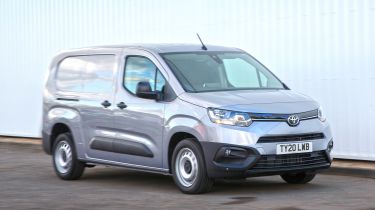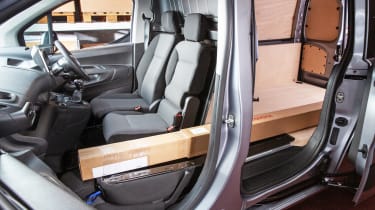Toyota Proace City van review
The Toyota Proace City joins the small van market, with a little help from the PSA Group
Think of a Toyota commercial vehicle, and the legendary Hilux pick-up truck is likely to spring to mind. But Toyota does have vans for sale in the UK as well. The mid-sized Toyota Proace has been on the market since 2016, and in 2020 it was joined by this smaller model, the Toyota Proace City.
And just like the mid-sized van, the Proace City has had some help coming to market. That's because it shares lots of its running gear with vans from the PSA Group, just as the Proace does. In fact, aside from the Toyota badges and the pointed grille design up front, the Proace City is practically identical to the Citroen Berlingo, Peugeot Partner and Vauxhall Combo.
Having said that, the Proace City isn't a like-for-like match to its siblings in terms of specification and engines. Toyota has gone its own way and has cherry-picked the options available to buyers. It believes that it has the best spec available for potential buyers at the price, and is targeting sole traders and small to medium-sized enterprises (SMEs) rather than big fleet orders at a knock-down rate. As a result, the Proace City starts from around £18,500, which is higher than its Citroen, Peugeot and Vauxhall counterparts, but the Proace City is better equipped in entry-level form than its sister models.
Used - available now

2020 MG
ZS ELECTRIC
14,664 milesAutomaticElectric
Cash £10,490
2024 MG
MG4 EV
16,050 milesAutomaticElectric
Cash £14,791
2025 BMW
3 Series
21,936 milesAutomaticPetrol3.0L
Cash £40,499
2023 Peugeot
2008
15,100 milesAutomaticPetrol1.2L
Cash £17,599Like its PSA counterparts, the Proace City is available in L1 and L2 body lengths, both in a single roof height. They offer cargo volumes of 3.3 and 3.9 cubic metres respectively and a payload of up to one tonne is available. There's no Crew Van version, while Toyota isn't bringing a Proace City Verso van-based MPV to the UK, either. What the Proace City does get as standard is twin-sliding side doors for both body lengths - this is only standard on the L2 versions of its siblings. A full steel bulkhead is fitted as standard, too, and you can add thru loading to help with carrying very long items if you add the twin passenger seat option to the entry level van - it's standard on the higher-spec version.
Under the bonnet, Toyota has gone with the PSA-sourced 1.5-litre diesel in 75hp and 100hp guises, but the most powerful 130hp engine isn't being offered. As a result all models come with a five-speed manual gearbox, and there's no auto box option. Other kit that's missing from the Proace City includes PSA's blind spot camera system, and there's no off-road pack with raised ride height and all-season tyres. It's worth noting that you can only get the L2 van with the 100 hp diesel in top-spec Icon trim.
Back to what the Proace City does have, and there are two trims on offer, Active and Icon, which mirrors the larger Proace. Active versions are packed with safety kit, with driver and passenger airbags (the latter is optional on its PSA siblings), curtain airbags, tyre pressure warning, hill start and downhill assist, stability control and brakeforce distribution included. On top of that, Icon adds tyre pressure monitors and a speed limiter, while Toyota Safety Sense (including pre-collision, road sign assist, lane departure and driver fatigue alert) is offered as an option.
Rivals for the Toyota Proace City include the closely related Citroen, Peugeot and Vauxhall variants, all of which offer some extra kit over the Proace City if you need it, although the cheapest versions aren't as well equipped. Elsewhere, the Ford Transit Courier and Connect are well worth checking out, as is the Volkswagen Caddy. The Renault Kangoo and closely related Mercedes Citan and Nissan NV250 are a bit dated in comparison to the Toyota, although the Kangoo ZE is an all-electric variant of the Kangoo that might be of interest. Nissan also has the e-NV200 electric van if you're city-based, while the Fiat Doblo is getting on in years, but still has a competitive carrying capacity.
MPG and Running costs
The Toyota Proace City is priced slightly higher than its PSA Group siblings, but it also gets more kit. Prices start from around £18,500 ex VAT, but you get a full suite of safety features, twin sliding side doors on both L1 and L2 versions, air-conditioning, auto lights, a USB socket and Bluetooth.
This is for the Active model, while the Icon adds some decent luxuries, including an 8-inch touchscreen with Apple CarPlay and Android Auto, front and rear parking sensors, a rear camera, cruise control and extra storage. If you want an L2 van, then this is the only trim you get and with the more powerful (but on paper more efficient) 100hp engine. It starts from around £22,000. While these prices are higher than those of the PSA vans, the Toyota has better forecast residual values, which helps to mitigate the extra outlay when buying.
Options include a ply lining, and the Smart Cargo system, which adds a second passenger seat and thru-loading bulkhead is offered as an option on the L1 van. Only Icon models can be fitted with an alarm with motion and tamper sensors, while the Toyota Safety Sense system, which adds road sign assist, lane departure warning and tiredness alert is also only offered on Icon variants.
Toyota has chosen to offer the two less powerful 1.5-litre diesels in the Proace City, in 75 and 100 guises. Fuel economy is yet to be confirmed, but the Citroen Berlingo has a WLTP-best of 55.6mpg (which is for the more powerful 100 engine), and you can expect similar from the Toyota. The fact that a five-speed gearbox is fitted as standard means the Proace City carries more revs at motorway speeds than it would if it had a six-speed box, so that might sway you away from the Toyota to its PSA alternatives.
The Toyota Proace City has a 50-litre fuel tank, and if you achieve up to 55mpg when driving, that gives it a potential range of 600 miles between fills. Emissions go as low as 108g/km for these engines, although while van tax rates are fixed for the moment, this isn't of much interest. The Proace City does rely on AdBlue to keep its emissions down, and the AdBlue tank is 17 litres in size.
Service intervals on the Proace City are every 25,000 miles or two years, whichever comes first. But while all Toyota dealers are set-up to sell the Proace City, not all of them can service it. That's something Toyota is addressing with its Toyota Professional brand, which aims to cater for business users with quick servicing turnaround. In addition, the Proace City benefits from Toyota's five-year/100,000-mile warranty, when its PSA Group siblings only get three years of cover, albeit with the same 100,000-mile limit.
Load space and practicality
In terms of carrying capacity, the Toyota Proace City gives nothing away to its PSA siblings, so it's a front-runner for space and payload weights. Starting with the L1 version, the Proace City van has a cargo capacity of 3.3 cubic metres. Add the Smart Cargo pack, and this increases to 3.8 cubic metres, although this is all located in the passenger footwell of the cab, and is only designed to accommodate longer loads. The L2 increases these dimensions to 3.8 and 4.4 cubic metres respectively.
Moving on to payloads, and the 75hp engine can carry 650kg in both trims, while the 100hp engine is able to carry up to one tonne. This is for the L1 version of the Proace City, the L2 van loses 50kg of load, at 950kg. One option that's missing from the Proace City that is available on Citroen and Peugeot variants is a load sensor. This piece of kit uses electronics to detect the weight being carried in the back, and can warn if the van is overloaded. It doesn't stop the van being driven, but is a useful option nonetheless.
The Smart Cargo set-up comprises of a modestly sized opening in the bulkhead that allows long items such as ladders or piping to be carried. Toyota does supply a high-strength canvas bag that attaches around the opening, so filthy items won't mess up the interior.
Dimensions inside the Toyota Proace City are competitive for the class. There's a minimum rear opening of 1,087mm wide by 1,196mm high with the 60:40 split doors fully open, and the side doors have an opening that's 675mm wide and 1,072mm high. There's enough floor space inside to fit a pair of Euro Pallets, with the L2 van being marginally longer, but just as wide. There's a load height of 1,200mm, while the width between the wheelarches is 1,229mm. Add the Smart Cargo pack, and you get 3,090mm of load length in the L1 van, and 3,440mm in the L2. All vans get six load hooks in the floor, while a rubber floor covering helps to prevent items from sliding about.
Reliability and safety
The Toyota Proace City uses the same electronic systems as its PSA Group siblings, so it's very advanced in terms of safety for a van. There are driver and passenger airbags as standard - some rivals still offer a passenger bag as an option - while ESP, ABS with brakeforce distribution (on standard-fit disc brakes all round), hill start and descent assist and tyre pressure warning are all fitted.
Icon models add tyre pressure monitors and a speed limiter, while Toyota Safety Sense, which adds road sign assist, pre-collision assist, lane departure warning and tiredness alert, is offered as an option. Icon adds front and rear parking sensors and a reversing camera, but Toyota has decided not to offer Surround Rear Vision or Flank Guard, two permanent camera systems that are available on the Berlingo, Partner and Combo.
While PSA Group models haven't had the best record for reliability in the past, that's not such an issue today. But with Toyota offering a five-year warranty on the Proace City, it clearly has faith that this van, even with all of its 'bought-in' technology, should be reliable.
Van security
Remote central locking is fitted, but Toyota only offers an alarm with motion and tampering sensors on the Icon version. Unlike some rivals, Toyota doesn't offer window glass for the Proace City's cargo doors, so prying eyes will need to look elsewhere to find a possible target for theft. The steel bulkhead also prevents access to the load area, and there is separate locking on the keyfob, too.
Driving and performance
With 75hp and 100hp engines on offer, the Toyota Proace Verso isn't the quickest van around. 0-62mph takes 11.5 seconds for the 100hp engine and a lethargic 15.8 seconds for the 75hp version. We've tried the 100hp version, and even when the van is unladen you need to give it plenty of revs to get going. Max power is available at 3,500rpm, which is positively screaming for a diesel, and the van doesn't really get going until you're up past 2,000rpm.
This performance isn't helped by the PSA-sourced gearbox. The five-speed unit has widely spaced ratios to maximise fuel efficiency, but the shift action is spongy and not very positive. There are occasions where you need to double check that a gear has actually slotted home, especially if you've put it in neutral to let the stop-start system engage. The system itself is quick to react, though, so you'll save plenty of fuel at the lights, although you'll probably burn it all as you try and keep pace with the traffic, especially if you're making full use of the 100hp van's one tonne payload.
Once up to speed the Toyota Proace City is quite refined for a van. It's reasonably quiet, and it handles pretty well, thanks to the fact the front part of the chassis is sourced from the PSA Group's passenger car range. The suspension is a little unsettled when unladen, but that's sure to settle with some weight in the back, while the view out helps you to position the van on the road with ease. Light steering helps with low-speed manoeuvring, as do the front and rear parking sensors and reversing camera on Icon vans.
Cab and interior
Inside, the Toyota Proace City uses the same dashboard as the Citroen Berlingo Van's, rather than Peugeot Partner's iCockpit layout. That means a large steering wheel with dials located behind it, not a small wheel with the dial pod located above the rim of the wheel. This is arguably a more comfortable layout than the Peugeot's.
Build quality is good, with hard-wearing plastics and fabrics used throughout, and solid-feeling controls. There are carpets inside (although you can add rubber mats if you want) and electric windows and air-con boost cabin comfort. Icon vans get a colour touchscreen, and again the graphics are largely identical to the Berlingo Van's. It's a bit tricky to use on the move, but at least the climate controls are physical knobs set under the touchscreen. Apple CarPlay and Android Auto are compatible with this system, which takes care of navigation, while Bluetooth is standard on all vans.
Space inside is good for the driver, although the two passenger seats will be snug if you travel three-up. Storage includes twin gloveboxes (the upper one is particularly roomy), overhead trays, decent door bins and 12v and USB connections in useful positions. Icon vans get a second lidded storage area above the dials, too.
Van dimensions
| Body style | Height | Width | Length |
| L1 | 1,880mm | 1,848mm | 4,403mm |
| L2 | 1,880mm | 1,848mm | 4,753mm |
Width is body without side mirrors, overall width including mirrors folded is 2,107mm)
Load area dimensions
| Body style | Height | Width | Length | Volume |
| L1 | 1,200mm | 1,527mm | 1,817mm | 3.3m3 |
| L2 | 1,200mm | 1,527mm | 2,167mm | 3.9m3 |
(Widths are maximum, width between wheel arches is 1,229mm)
















